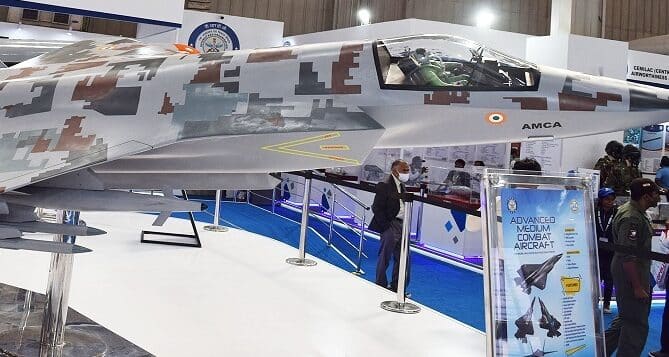Aerospace
By 2028, India’s AMCA fifth-generation fighter jet prototype may fly.
India has been competing with numerous other countries in the development of a fifth-generation fighter jet.

According to representatives of the Aeronautical Development Agency (ADA), a part of India’s Defence Research and Development Organization, the plan then needs approval from the Cabinet Committee on Security (CCS) (DRDO). The CCS will soon approve the AMCA, according to media reports.
“Once the project approval is secured, the first prototype may be put out in three years, and the maiden flight can be in one to one and a half years after that,” AMCA Project Director AK Ghosh said at the just concluded Defence Expo, where a model of the AMCA was shown last week. This timeline indicates that the AMCA will take to the skies for the first time in 2028.
Along with choices about the defense budget, the CCS, which reports to the Cabinet Secretariat, is in charge of making significant appointments and decisions regarding matters of national security.
The CDR attempts to finish the analysis, simulations, drawings, and testing in order to finalize designs.
Most of the indigenous products for the Tejas Mark 2 are also being developed by HAL and DRDO, such as the Pilot ejection seat and the Mid Air Refueling knob, which will aid the AMCA project greatly if they are successful.
The Tejas Mark 2 is slated to fly for the first time early next year, likely concurrently with its involvement in the AMCA, which will be India’s most eagerly anticipated project. Many other nations, including the USA, the UK, and Japan, have expressed a desire to participate in the development. Additionally, engine manufacturers Safran, GE, and Rolls Royce are also interested in collaborating on AMCA projects.
Rolls Royce in talks with DRDO to rev up AMCA engines(Opens in a new browser tab)
The AMCA would be a stealth fighter jet weighing 25 tonnes that had twin engines and an internal weapons bay. A Driverless Supersonic Intake, which was created for the first time in India, will also be included. It is useful to compress the air that prevents Mach speed breach while directing boundary layer airflow away from the aircraft’s engine, doing so without the need for a splitter plate.
The aircraft’s radar cross-section can be reduced by the internal weapons bay, which has a payload capacity of 1500 kg, an exterior payload of 5,500 kg, and an internal fuel capacity of 6,500 kg. This will increase the stealth of the aircraft.

Aerospace
Boeing Transfers Rocket Stage to NASA, Paving Way for Human Moon Mission

Boeing has achieved a significant milestone by providing NASA with the second core stage of the Space Launch System (SLS) rocket.
This crucial component, crafted at NASA’s Michoud Assembly Facility (MAF), is set to propel the Artemis II crew into lunar orbit, marking humanity’s return to deep space after a 50-year hiatus.
The monumental Boeing-built rocket stage, the largest element of the Artemis II mission, will embark on a journey aboard the Pegasus barge, traveling 900 miles to NASA’s Kennedy Space Center.
Comparison of two legendary aircraft B777x vs B747 aircraft:Click here
Upon arrival, it will be meticulously integrated with other essential Artemis II components, including the upper stage, solid rocket boosters, and NASA’s Orion spacecraft within the iconic Vehicle Assembly Building. This intricate integration process is a vital step toward the eagerly anticipated Artemis II launch, slated for 2025.
“Boeing-built products helped land humankind on the moon in 1969, and we’re proud to continue that legacy through the Artemis generation,” remarked Dave Dutcher, vice president and program manager for Boeing’s SLS program. “Together, with NASA and our industry partners and suppliers, we are building the world’s most capable rocket and paving the way to deep space through America’s rocket factory in New Orleans.”
NASA, Lockheed Martin Reveal X-59 Quiet Supersonic Aircraft:Click here
The delivery of Core Stage 2 marks a significant achievement in the evolution of the SLS rocket. Towering over 200 feet and powered by four RS-25 engines, this core stage, coupled with two solid-fueled booster rockets, will generate a staggering 8.8 million pounds of thrust. This immense power is crucial to launching Artemis II and future missions into the vast expanse of space.
The SLS rocket stands unparalleled in its capability to transport both crew and substantial cargo to the moon and beyond in a single launch. Its extraordinary capacity will facilitate the delivery of human-rated spacecraft, habitats, and scientific missions to destinations including the moon and Mars, ushering in a new era of space exploration.
-

 Travel1 week ago
Travel1 week agoAir India to Expand US Operations with Three New Routes After a Decade
-

 Travel2 weeks ago
Travel2 weeks agoWhy We Should Avoid These Stamps in a Passport
-

 Airlines1 month ago
Airlines1 month agoInvestigations Reveal Fake Chinese Titanium in Boeing and Airbus Jets
-

 Tech4 weeks ago
Tech4 weeks agoChina’s CATL Plans 1,800-Mile Electric Plane Launch by 2027
-

 Airport3 days ago
Airport3 days agoTop 10 Largest Airports in the World by Size
-

 Aerospace4 weeks ago
Aerospace4 weeks agoChina’s Fighter Jets Turn Wings into Autonomous Drones
-

 Airlines4 days ago
Airlines4 days agoAir India Rolls Out A350s for Delhi-New York JFK and Newark Routes
-

 Defence3 weeks ago
Defence3 weeks agoBoeing Enhances Chinook with New Engines and Block II Upgrades at $96 Million







